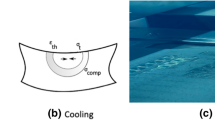Abstract
The influence of cutting on the surface roughness and undulation of AMg2 aluminum alloy with regular and ultrafine grain structure is considered. The quantitative influence of profile filters on its surface roughness and undulation is established, on the basis of 2D parameters. In the machining of materials with ultrafine grain structure, the surface quality is better than for materials with regular grain structure.


Similar content being viewed by others
REFERENCES
Valiev, R., Islamgaliev, R., and Alexandrov, I., Bulk nanostructured materials from severe plastic deformation, Prog. Mater. Res., 2000, vol. 45, no. 2, pp. 103–189.
Filippov, A.V. and Gorbatenko, V.V., Influence of rake angle tool on plastic deformation in chip formation when cutting, Appl. Mech. Mater., 2014, vol. 682, pp. 525–529.
Filippov, A.V., Cut-layer cross section in oblique turning by a single-edge tool, Russ Eng. Res., 2014, vol. 34, no. 11, pp. 718–721.
Filippov, A.V. and Proskokov, A.V., Analysis of chip forming in metal cutting by digital correlation speckle-interferometry, Vestn. Mosk. Gos. Tekhnol. Univ., Stankin, Ser. Mashinostr., 2014, no. 2, pp. 100–113.
Korovin, G.I., Filippov, A.V., Proskokov, A.V., and Gorbatenko, V.V., Cutting edge geometry effect on plastic deformation of titanium alloy, IOP Conf. Ser.: Mater. Sci. Eng., 2016, vol. 125, art. ID 012012.
Filippov, A.V., Nikonov, A.Y., Rubtsov, V.E., et al., Vibration and acoustic emission monitoring the stability of peakless tool turning: experiment and modeling, J. Mater. Process. Technol., 2017, vol. 246, pp. 224–234.
Filippov, A.V., Rubtsov, V.E., Tarasov, S.Yu., et al., Detecting transition to chatter mode in peakless tool turning by monitoring vibration and acoustic emission signals, Int. J. Adv. Manuf. Technol., 2017, vol. 10, pp. 1–13.
Filippov, A.V., Rubtsov, V.E., and Tarasov, S.Yu., Acoustic emission study of surface deterioration in tribocontacting, Appl. Acoust., 2017, vol. 117, pp. 106–112.
Alfyorova, E.A. and Lychagin, D.V., Deformation relief in crystals as a way of stress relaxation, Lett. Mater., 2017, vol. 7, no. 2, pp. 155–159.
Lychagin, D.V. and Alfyorova, E.A., Slip as the basic mechanism for formation of deformation relief structural element, Phys. Solid State, 2017, vol. 59, no. 7, pp. 1433–1439.
Alfyorova, E.A. and Lychagin, D.V., Self-organization of plastic deformation and deformation relief in FCC single crystals, Mech. Mater., 2018, vol. 117, pp. 202–213.
Lychagin, D.V., Filippov, A.V., Novitskaia, O.S., et al., Friction-induced slip band relief of Hadfield steel single crystal oriented for multiple slip deformation, Wear, 2017, vols. 374–375, pp. 5–14.
Lychagin, D.V., Filippov, A.V., Kolubaev, E.A., et al., Dry sliding of Hadfield steel single crystal oriented to deformation by slip and twinning: deformation, wear, and acoustic emission characterization, Tribol. Int., 2018, vol. 119, pp. 1–18.
Kuznetsov, V.P., Smolin, I.Yu., Dmitriev, A.I., et al., Toward control of subsurface strain accumulation in nanostructuring burnishing on thermostrengthened steel, Surf. Coat. Technol., 2016, vol. 285, pp. 171–178.
Huang, B., Kaynak, Y., Arvin, C., and Jawahir, I.S., Improved surface integrity from cryogenic machining of Al 7050–T7451 alloy with ultrafine-grained structure, Adv. Mater. Process. Technol., 2015, vol. 1, pp. 361–374.
Asl, Y.B., Meratian, M., Emamikhah, A., et al., Mechanical properties and machinability of 6061 aluminum alloy produced by equal-channel angular pressing, Proc. Inst. Mech. Eng., Part B, 2015, vol. 229, pp. 1302–1313.
Tarasov, S.Yu., Filippov, A.V., Kolubaev, E.A., and Kalashnikova, T.A., Adhesion transfer in sliding a steel ball against aluminum alloy, Tribol. Int., 2017, vol. 115, pp. 191–198.
ACKNOWLEDGMENTS
Financial support was provided by the Russian Science Fund (project 17-79-10013).
Author information
Authors and Affiliations
Corresponding author
Additional information
Translated by Bernard Gilbert
About this article
Cite this article
Filippov, A.V., Tarasov, S.Y., Shamarin, N.N. et al. Surface Quality of AMg2 Aluminum Alloy with Ultrafine Grain Structure after Machining. 1. Turning. Russ. Engin. Res. 38, 1067–1070 (2018). https://doi.org/10.3103/S1068798X18120249
Received:
Revised:
Accepted:
Published:
Issue Date:
DOI: https://doi.org/10.3103/S1068798X18120249




